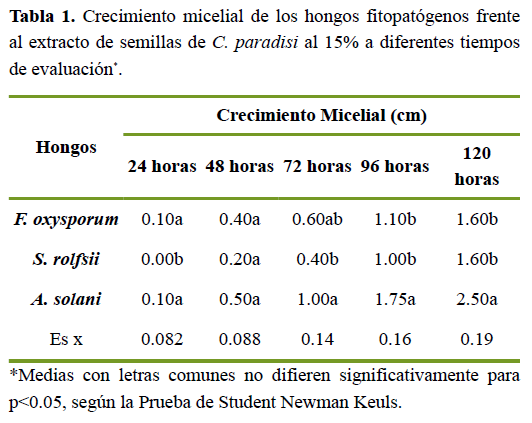Potentialities of floristic species from the Nipe-Sagua-Baracoa massif for the control of tomato phytopathogenic fungi
Main Article Content
Abstract
The biological activity of extracts obtained from Citrus paradisi and Citrus aurantium on strains of phytopathogenic fungi that affect tomato cultivation was studied. For this, in vitro bioassays were developed to evaluate the effect of ethanolic extracts on the mycelial growth of the fungi Fusarium oxysporum, Sclerotium rolfsii and Alternaria solani. The zonal inhibition method was used in plates, by seeding mycelial discs in inverted form, in Petri dishes with Papa-Dextrose-Agar medium (PDA). The extracts at the 15% concentration were deposited in perforations made in the medium and the plates were incubated at 24 ° C for 120 hours. The evaluations were carried out every 24 hours for 5 days and consisted of measuring the growth of the colonies. A significant inhibition was observed in the growth of the Sclerotium rolfsii strain, the causative agent of tomato wilt. A completely randomized design with a factorial arrangement was used, the variation factors being the strains and the plant extracts. Each treatment was replicated 3 times with control water or ethanol treatments as appropriate. The data were subjected to Analysis of Variance and the means were compared using the Student Newman Keuls test (p <0.05).
Article Details

This work is licensed under a Creative Commons Attribution-NonCommercial 4.0 International License.
References
Balatti, P.A.; López, S.M.Y.; Franco, M.E.E. y Lucentini, C.G. (2018). Tomate: hongos patógenos, bacterias endófitas y biocontrol. Documento de conferencia. I Encuentro de Centros Propios y Asociados de la CIC.
Cueva, A. y Everson, G. (2018). Plagas y enfermedades presentes en cultivo hidropónico de dos variedades de tomate (Lycopersicon esculentum, Mill), bajo condiciones semicontroladas en Chachapoyas - Perú. Tesis presentada en opción al título de Ingeniero Agrónomo Universidad Nacional Toribio Rodríguez de Mendoza. Facultad de Ingeniería y Ciencias Agrarias.
Jones, J.B.; Stall, R.E.; Zitter, T.A. (2017). Plagas y enfermedades del tomate. México, D.F., Ediciones Mundi-Prensa, 74 p.
Noguera, A.; Salmerón, F.; Reyes, N. (2019). Bases teórico-metodológicas para el diseño de sistemas agroecológicos. Revista de la Facultad de Ciencias Agrarias, 51(1): 273-293.
Rubio, Teresa (Comp.). (2013). Producción y consumo sostenibles. Imperativos de una estrategia de desarrollo económico, Editorial Científico-Técnica, La Habana.
Trabuco, Miriam B.; Gómez, V.A.; Ramírez, María B. 2015. Evaluación de extractos vegetales para el control de la palomilla del tomate Tuta absoluta (Meyrick) en condiciones de invernadero. Investig. Agrar., 17(2): 138-142.

